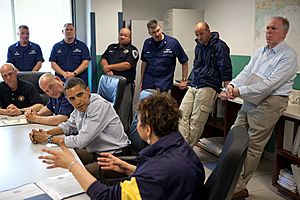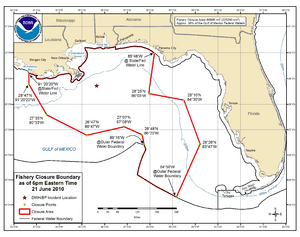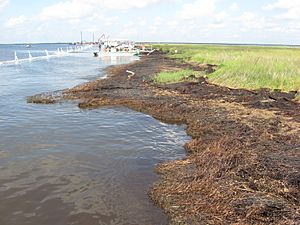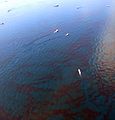Deepwater Horizon oil spill facts for kids
The Deepwater Horizon oil spill (also known as the "BP oil spill") was a huge accident that started on April 20, 2010. It happened in the Gulf of Mexico at an oil well called Macondo Prospect, which was operated by BP. This event is known as the biggest oil spill in the ocean ever. Experts believe that about 4.9 million barrels of oil spilled into the sea. After many tries to stop the oil, the well was finally sealed on September 19, 2010. However, some reports in 2012 said that oil was still leaking from the site. The Deepwater Horizon oil spill is seen as one of the biggest environmental disasters in American history.
Quick facts for kids Deepwater Horizon oil spill |
|
|---|---|
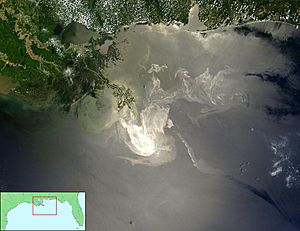
The oil seen from space by NASA's Terra satellite on 24 May 2010
|
|
| Location | Macondo Prospect (Mississippi Canyon Block 252), in the North-central Gulf of Mexico, United States (south of Louisiana) |
| Coordinates | 28°44′17″N 88°21′58″W / 28.73806°N 88.36611°W |
| Date | 20 April – 19 September 2010 (4 months, 4 weeks and 2 days) |
| Cause | |
| Cause | Wellhead blowout |
| Casualties | 11 people killed 17 people injured |
| Operator | Transocean under contract for BP |
| Spill characteristics | |
| Volume | 4.9 million barrels (210,000,000 U.S. gallons; 780,000 cubic meters) ±10% |
| Area | 2,500 to 68,000 sq mi (6,500 to 176,100 km2) |
A huge effort began to protect beaches and important natural areas like wetlands (swampy lands) and estuaries (where rivers meet the sea). They used special ships to skim oil, floating barriers called booms, controlled fires, and chemicals called dispersants to break up the oil. Because the oil spilled for months, and due to the cleanup efforts, there was a lot of harm to ocean animals, plants, and the fishing and tourism businesses.
In Louisiana, about 4.9 million pounds of oily material were removed from beaches in 2013. This was more than twice the amount collected in 2012. Cleanup crews worked four days a week on 55 miles of Louisiana shoreline throughout 2013. Oil was still found far from the spill site, even off the coast of Florida. Scientists said the mix of oil and dispersant was stuck in the sand there. In April 2013, it was reported that dolphins and other sea animals were still dying in large numbers. Baby dolphins were dying six times more often than normal. A study in 2014 found that tuna and amberjack fish exposed to the oil had problems with their hearts and other organs. These problems would likely cause them to die or live shorter lives. Another study found that the oil might have caused heart damage in many animals.
Many investigations looked into why the explosion and spill happened. A U.S. Government report in September 2011 said that bad cement on the well was a main cause. It mostly blamed BP, but also the rig operator Transocean and the company Halliburton. Earlier in 2011, a White House group also blamed BP and its partners. They said the companies made choices to save money and did not have a good safety system. The group also said the spill happened because of bigger, "systemic" problems. They warned that without big changes in how the industry and government work, similar accidents could happen again.
In November 2012, BP and the United States Department of Justice reached an agreement about federal charges. BP admitted responsibility for the deaths of 11 people and other serious issues. BP also agreed to have its safety and ethics checked by the government for four years. The United States Environmental Protection Agency (EPA) said BP would be temporarily stopped from getting new contracts with the U.S. government. BP and the Department of Justice agreed to pay a record $4.525 billion in fines and other payments. By 2018, the company had spent more than $65 billion on cleanup costs, charges, and penalties.
In September 2014, a U.S. District Court judge decided that BP was mainly responsible for the oil spill. This was because of its very careless and risky actions. In April 2016, BP agreed to pay $20.8 billion in fines. This was the largest payment ever made by a company in United States history.
Contents
Effects on the U.S. Oil Industry
On May 27, 2010, U.S. President Barack Obama temporarily stopped new drilling for oil in the ocean. He also made new safety rules to try to prevent other oil spills. British Petroleum (BP Oil) owned the Deepwater Horizon oil rig. This company was mostly responsible for the harm caused by the oil spill. They paid billions of dollars to help people who could not work after the oil spill. They also paid for the cleanup efforts.
Help for People and Businesses
On May 3, 2010, a group called The Gulf Coast Claims Center started to pay for emergency help. This help went to businesses and people, like fishermen, who could not work because of the oil spill. By the end of August 2010, this center had paid more than $395 million. About one-third of this money went to the fishing industry. By February 2011, the center had paid about $751 million to people in the fishing business. People had three years to figure out their losses and ask for payment.
BP also started a program called the Vessels of Opportunity Program. This program hired local people, who would normally be fishing, to use their boats to help clean up the spilled oil. However, this program did not help much with the spill because the boats were not set up to collect oil.
There are other ways for people in the U.S. fishing industry to get money back for what they lost. For example, the Oil Spill Liability Trust Fund was started after the 1989 Exxon Valdez oil spill. It helps people harmed by oil spills. Another law, the Magnuson-Stevens Fishery Conservation and Management Act, lets the U.S. government help when fishing has completely failed in an area.
Effects on the Fishing Business
On May 2, 2010, 12 days after the Deepwater Horizon explosion and fire, the National Oceanic and Atmospheric Administration (NOAA) closed a large area of the Gulf of Mexico to fishing. This was to make sure that seafood possibly poisoned by oil would not be sold and make people sick. The U.S. government closed large areas to fishing. These areas stretched from Louisiana, across the coasts of Mississippi and Alabama, and as far as Panama City in Florida. State waters in much of the same area were also closed. The largest area closed to fishing was 88,522 square miles on June 2, 2010. By the end of November 2010, most of the waters were opened for fishing again. Only 1041 square miles were still closed. However, some oil residue was still found. For example, tar balls were sometimes found in shrimpers' nets.
Short-Term Environmental Effects
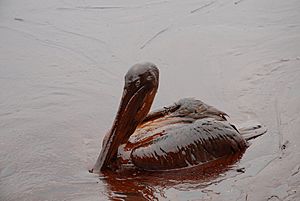
Some animals and plants were hurt by the Gulf oil spill. Scientists found dead, oil-covered animals like birds, fish, shrimp, and oysters. Large, decaying fish covered in thick, dark oil washed up on some beaches. The NOAA found 1,746 birds. 1,014 of these birds had oil on them, 997 were dead, and 749 were alive. The NOAA also found 528 sea turtles, with 400 dead and 128 alive. The NOAA found 51 mammals, including dolphins, with 47 dead and 4 alive. Some scientists cut open dead fish to look inside and found oil in their gills and hearts.
Because fishing was stopped, many small fishing supply stores could not make money. Fishing companies did not have enough fish and lost customers. Normally, many people travel to this area to fish for fun. Because of the oil spill, fewer people traveled there. So, travel businesses and people who help visitors also lost money.
East of Mobile Bay, damage from oil spill cleanup crews and vehicles caused more harm to the delicate sand dune areas than the oil spill itself. Dune habitats can be destroyed by just light foot traffic. They definitely cannot handle hundreds of vehicles. Even with much evidence, BP still denies this.
After Hurricane Isaac in September 2012, about 565,000 pounds of oily material linked to the spill washed ashore. This was more than had been collected in the eight months before. The Louisiana Coastal Protection Agency criticized BP and the U.S. Coast Guard's cleanup efforts. They asked for more help to deal with the roughly 1 million barrels of oil believed to still be underwater. Huge tar mats were also uncovered during the storm, causing beaches to close.
Environmental Effects Over Time
Scientists have thought about how much the plants and animals in the Gulf of Mexico would change after the oil spill. In general, chemicals in oil can hurt fish and shellfish. In their early life stages, many kinds of fish grow near the shore. So, oil at the shore might change how many fish there are in future years. Also, affected species are part of a food web or provide homes for other kinds of animals. These things are possible, but there is not yet much actual information on how fish and shellfish are doing after the oil spill. Most shrimp grow in one year. So, changes in the number of shrimp caused by the Gulf oil spill will be known one or two years after the spill. It takes years for many kinds of fish to grow large enough to be caught for food. So, it will take years to know the effects of the Gulf oil spill on very small fish.
The NOAA is still helping animals hurt by the Gulf oil spill. However, not many more injured animals are being reported. Instead, the NOAA is spending more time letting wildlife go back into the ocean. For example, sea turtles that were saved from the oil are being released back into the wild ocean. NOAA scientists on research boats have also been checking if it is now safe to eat fish from the Gulf (they have found that it is safe).
Counting done by Dauphin Island Sea Lab after the oil spill found that there were actually more of some kinds of fish a few months after the oil spill. This was off the coasts of Mississippi and Alabama. Some scientists think that closing fishing areas kept the total number of fish high despite the oil spill.
One-third of the oysters sold in the United States come from Louisiana. However, the places where oysters grow have been hurt by recent hurricanes, higher than usual amounts of fresh water coming down the rivers (oysters need salt water), and also the Gulf oil spill. The Louisiana Division of Wildlife and Fisheries has been working with scientists at universities on better ways to grow oysters. Also, in June 2011, more than 100 million oyster seeds and 500,000 baby oysters were put in test areas to help the oyster areas grow back.
The U.S. National Marine Fisheries Service thinks that the 2011 brown shrimp harvest from waters off Mississippi and Louisiana will be only a little bit lower than usual. It is expected to be a much better harvest than in 2010 after the oil spill. Good weather in the spring of 2011 helped the brown shrimp grow well.
Images for kids
-
Striped dolphins (Stenella coeruleoalba) observed in emulsified oil on 29 April 2010
-
Sign in Orange Beach, Alabama advising against swimming due to the oil spill
-
American protester stands on a Union Flag, presumably associating BP with the United Kingdom


